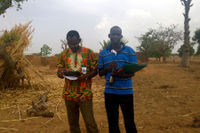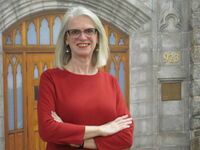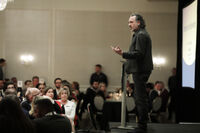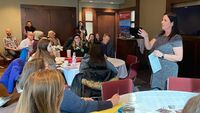By Jordan Whitehouse |
Whether through luck or sheer determination, Kebba Touray has always found a way to defy expectations.
Growing up in a small village in the Central River Region of The Gambia, for instance, where few children could get a formal education in the early 1980s, Touray was the lucky one; out of five siblings, his stepdad chose him to go to primary school.
Even after excelling in primary and high school, he remembers thinking his education was over. “I had fears that I may not have had the opportunity to go to university,” he says over the phone from Nigeria, where he’s now a geographic information systems (GIS) expert. “At that time, you had to either have a scholarship to travel out of the country to secure university education or be able to pay as a private student.” He didn’t have a scholarship or the money.
But luck struck again, this time in the form of the Saint Mary’s University Extension Program (UEP), a now-defunct partnership between The Gambia Government, the Nova Scotia Gambia Association, and Saint Mary’s University. Professors from SMU would travel to The Gambia to deliver the lectures and course materials that students needed to graduate with degrees.
It was the first university in the country, so entrance through scholarship—Touray’s route—was highly competitive. You guessed it, though: he snubbed expectations and won a scholarship, choosing a four-year degree in geography at UEP. “I got into Saint Mary’s and chose geography,” he says, “in order to build a career in an area that I could use to benefit my people.” And benefit them, he did.
After graduating with that bachelor’s degree in 2000, he worked as a field assistant and then a field supervisor with the Medical Research Council Unit The Gambia (MRC), where he researched ways to increase the detection of tuberculosis in West Africa and how to improve patients’ adherence to treatment.
While there, he also saw there was a need for a GIS specialist at the MRC, and so, thinking he could fill that gap, he travelled to Kingston University London, UK, where he eventually earned an MSc (with Commendation) in Applied GIS in 2005.
But again, after graduating and deciding to return to the MRC, there were expectations—this time from friends and family who thought he should stay in the UK. He didn’t listen. “I was determined to come back because it is our responsibility as people coming from the villages to go back and help.”
He believed that the knowledge he picked up in the UEP and in London would be more useful to the country he grew up in than the one he adopted for a few years. “We had very little experience in GIS at the time,” he says of The Gambia. “But going community to community, house to house, I saw how you can use geography to identify the spatial distribution of some of these public health diseases. Then you can tell the government where to locate health facilities, for example.”
Touray continued to use his education to help others when he became a GIS and mapping officer with the Economic Community of West African States (ECOWAS), an organization consisting of 15 West African countries promoting economic integration and peace, in 2010.
Then, in 2013, the World Health Organization came knocking. They needed a GIS expert on a short-term contract to support polio eradication efforts in Nigeria, which, at that time, accounted for more than half of all polio cases worldwide. His colleagues thought he was crazy to leave a full-time job with ECOWAS, but again he didn’t listen. He knew this would be one of the most important projects he’d ever be a part of. He was right.
The GIS portion of the project was funded by the Bill and Melinda Gates Foundation, and involved the development of a vaccination-tracking system that pinpointed which settlements in the country had received vaccinations and which had been missed. This system, coupled with other partners’ efforts, led to Nigeria’s removal from the polio-endemic list.
Today, the 41-year-old is back at ECOWAS working as a principal program officer, where he monitors conflict areas and provides information to policymakers on solving those conflicts.
Thankfully he hasn’t had to defy any expectations recently, but he doesn’t seem to care if he’ll have to any time soon. “This is an area that gives me so much joy because it’s the opportunity to use systems for solving real-world problems,” he says. “Studying geography at Saint Mary’s was a building-block that gave me this opportunity, and I am very thankful. I will never forget it.”




